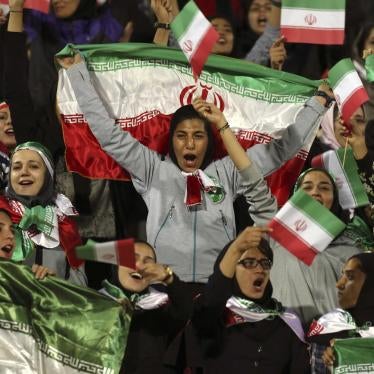(New York) – An Iranian Supreme Court ruling barring from government positions a former judiciary figure linked to protester deaths after the disputed 2009 presidential election is a step toward justice, but far from adequate. In 2010 a parliamentary committee had found Mortazavi responsible for the deaths of three persons due to his ordering their transfer to the Kahrizak detention facility, where torture was reportedly rife.
The official Islamic Republic News Agency (IRNA) reported on November 15, 2014, that the court had confirmed a Tehran criminal court’s decision to ban the former Tehran prosecutor and judge, Saeed Mortazavi, from ever again holding judicial office and from occupying a government post for five years. He was barred from the positions because of his alleged involvement in 2009 in the “unlawful detention” of protesters, several of whom died. Iran’s Tasnim News Agency reported on November 16 that Mortazavi plans to challenge the Supreme Court ruling, claiming that it was issued unlawfully.
“The Supreme Court’s ruling against Mortazavi is a belated recognition that high-ranking officials implicated in abuses against detainees should be held accountable,” said Sarah Leah Whitson, Middle East and North Africa director. “But it is not enough just to bar him from office, or to let officials involved in ordering the unlawful detention of protesters, which led to their injury and death, to go scot free.”
The detentions Mortazavi ordered allegedly resulted in the deaths of Amir Javadifar, Mohammad Kamrani, and Mohsen Ruholamini. Mortazavi and other judiciary authorities have denied that the detainees’ deaths were linked to injuries at Kahrizak, which was closed in late 2009 by order of Iran’s supreme leader. After its closure, the authorities prosecuted and convicted a number of mostly low-ranking officials for abuses at Kahrizak, but no high-ranking security or judiciary officials have been convicted and jailed in connection with the torture and deaths of detainees at Kahrizak.
In July 2009, Iran’s parliament set up a Special Parliamentary Committee to Investigate the Status of Post-Election Arrestees to examine allegations of torture and other abuse of detainees arrested as part of the post-election crackdown. The panel’s report, in January 2010, said that Mortazavi claimed that he ordered detainees sent to Kahrizak because of a lack of capacity at Tehran’s main Evin prison. But Evin prison authorities denied that and said they had been ready to accept the detainees.
The panel concluded that Mortazavi’s decision to transfer protesters to Kahrizak was “not justifiable even if Evin did not have the capacity” to take them, and ruled that Mortazavi was responsible for the deaths of Javadifar, Kamrani, and Ruholamini. The inquiry also named Ali Akbar Heidarifard and Hasan Haddad Dehnavi, two of Mortazavi’s deputies, as suspects in the case.
In December 2009, a military court tried 11 police officers and a private citizen who allegedly collaborated with the police on murder charges arising from the deaths of detainees at Kahrizak. On June 30, 2010, Iranian media reported that the court had convicted all but one of the defendants, sentencing two to death as well as fines, lashings, and compensation payments to the victims’ families. Nine others were sentenced to undisclosed prison terms and fines. The court acquitted the highest-ranking defendant, General Azizollah Rajabzadeh, Tehran’s police chief at the time of the 2009 crackdown, of all charges.
The military court conducted the trial behind closed doors and failed to investigate senior police and judiciary officials such as Mortazavi, Dehnavi and Heidarifard, and Esmail Ahmadi Moghadam and Ahmad-Reza Radan, respectively commander and deputy commander of the Law Enforcement Forces, which operated the Kahrizak facility at the time of the detainees’ deaths.
Soon after the military court’s ruling, family members of the detainees who died at Kahrizak declared that they had forgiven the two officers the court sentenced to death so that the families could “witness the punishment of the real perpetrators.” The families have since pursued their case against Mortazavi, Dehnavi, and Heidarifard, whom they hold responsible.
Mortazavi and his two former deputies all lost their positions in the judiciary – and thus their immunity against prosecution – in 2010 as a result of the investigations into their involvement in the deaths at Kahrizak. Despite the evidence linking Mortazavi to serious rights abuses, former President Mahmoud Ahmadinejad appointed Mortazavi to cabinet posts, first as head of Iran’s Task Force Against Smuggling and later as head of the Social Security Organization.
Human Rights Watch has repeatedly called on the Iranian authorities to publicly disclose the number and status of official criminal investigations into the role of Mortazavi and other high-ranking officials for the abuses perpetrated at Kahrizak, and to investigate and prosecute Mortazavi for his alleged involvement in other serious rights abuses.
“If the Iranian authorities have evidence that senior figures were responsible for torture or deaths in custody, they need to do more than reduce their job opportunities,” Whitson said. “They need to show that officials responsible for such crimes can be brought to justice if they are to demonstrate that Iran is on the path to real rights reform, let alone convince the victims’ families that justice has been served.”





